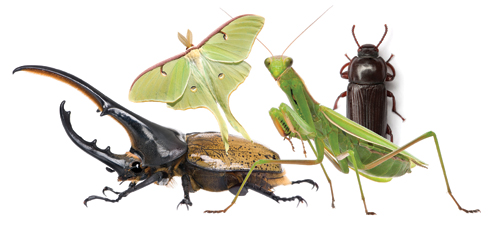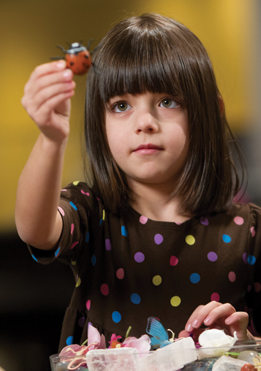 Winter 2012
Winter 2012|
“They are far and away the overwhelming, dominant form of living things. If the Martians came to check us out, they would go away thinking this is a strange planet of bugs.”
- John Rawlins, Interim Co-Director, Carnegie Museum of Natural History
|
Going Buggy
Carnegie Museum scientists and Carnegie Mellon School of Design students show there’s plenty to love about bugs. Lauren Cicozi was psyched about helping create a museum exhibition—that is, until she found out it was all about bugs. The sight of a centipede or worm made the Carnegie Mellon University design student want to run for cover. “I really don’t like the squirmy stuff,” she confesses. “I just wasn’t into bugs.” So, how on earth did she find inspiration during a nine-month-long collaboration surrounded each day by tarantulas, giant beetles, and even bigger water bugs? As Cicozi began hanging around Carnegie Museum of Natural History’s invertebrate zoology department, she found the scientists’ enthusiasm for creepy-crawlies contagious. In turn, John Rawlins, the department’s affable head curator with the look of a field-tested scientist, came to appreciate the way Cicozi and other CMU students viewed these creatures through the lens of design. Design meets science in BugWorks, a partnership between 18 CMU design students, their professors, and the museum’s eightmember invertebrate zoology team. It’s not your typical entomology display featuring drawer after drawer of dried and pinned insects. The exhibition gives visitors a look at live eastern lubber grasshoppers, Mexican red-kneed tarantulas, giant water bugs, and other creatures as they crawl around their cases perched on a sprawling table.
It also includes an area where kids (and kids at heart) can sort plastic bugs by color and body type to create their own insect collections. CMU students adorned the exhibition’s walls with close-up photos of compound eyes, high-resolution insect portraits, bug “blueprint” drawings, and videos of entomologists—insect scientists —in action. “It’s the aesthetics that grab you and tug at your heartstrings and help you negotiate the concept,” says Sarah Cole, director of exhibitions and gallery experiences at the Museum of Natural History. “They were amazing students, just rock stars.” As part of their senior project, the design majors broke into teams, developed exhibition ideas, and presented them to the museum staff. After graduation in May, Cicozi and fellow student Jeffrey Stoebe stayed on over the summer to help design professors Stacie Rohrbach and Mark Baskinger bring the group’s vision to life. Ethan Frier, now a senior, joined the project as a videographer, and filmed the scientific staff—at work in the field, meticulously pinning, or drawing bug after bug for study. This is the second time the pair of CMU professors have helped lead a student-driven effort at the museum, following a 2010 exhibition on birds. The museum hopes the hip design aesthetic of the 20-something students will help draw that hard-to-reach age demographic through the museum hallways to the Experimental Gallery, a rear first-floor space dedicated to collaborative exhibitions between the museum and its educational partners.
BugWorks is the first step in bringing the lowly bug—swatted by the public and dwarfed by the museum’s wildly popular dinosaur exhibition— back into the limelight. The museum hosted a popular bug zoo in the 1990s, but closed it due to inadequate funding. Rawlins, who is currently interim co-director of the museum, hopes to revive the menagerie in coming years by using some of the innovative design techniques tested in the Experimental Gallery, plus some additional surprises. Rawlins, a butterfly and moth specialist who admits that even he’s a little creeped out by tarantulas, says the sheer diversity of bugs is what keeps him enthralled 27 years after joining the museum. “Bugs” is a nonscientific term that encompasses insects, arthropods (spiders), and crustaceans (lobsters, crayfish, and their relatives). “Bugs are just these massively fascinating things, even for people who are afraid of them,” says Rawlins. “They are far and away the overwhelming, dominant form of living things. If the Martians came to check us out, they would go away thinking this is a strange planet of bugs.” This worldview gradually rubbed off on the 22-year-old Cicozi, who is now more open and empathetic to her subject matter. “We wanted to see them not as good bugs or bad bugs,” she recalls, “but to show that this is how bugs work. We wanted to appreciate them as these little creatures that live in their own world and do their own jobs.” Those invaluable bug jobs include pollinating flowers, decomposing organic material, and providing biological controls by eating other bugs. While Stoebe, 22, actually liked bugs going into the project, he says hanging out with entomologists made him even more appreciative of “the strange and wonderful forms that life can take.” He especially enjoyed helping to display the live bugs. “Our designs were based on what we felt would best connect people with our subject matter.” The glass display cases allow visitors to observe live bugs in ways they cannot in nature. CMU professor Baskinger recently joined a group of visitors gathered around the grasshopper to watch as it munched on dogwood fruits. “It’s slow and diligent when it eats,” he notes. “It’s a beautiful performance.” With the designers approaching insects from one angle and the scientists from another, a natural push and pull emerged as the group hashed out ideas. When the students first suggested a sorting table stocked with plastic bugs, an idea drawn from the recent M is for Museum exhibition, Rawlins thought, “What are we doing? What about our scientific methods?” But his skepticism disappeared as soon as the exhibition opened. “The kids came right to it,” he admits. “They didn’t need any instruction. We saw one kid sorting all the green bugs. He was doing the same process we do—without DNA analysis and electron microscopes. He was understanding natural history.”
|
Our Place in Space · Breaking Out of the Cube · Reimagining Home · Southern Exposure · Directors' Note · NewsWorthy · Face Time: Tina Kukielski · Artistic License: Hacking Reality · Field Trip: Where in the World is Carnegie Museums? · The Big Picture
 |
Copyright © 2017 CARNEGIE Magazine. All rights reserved. |


